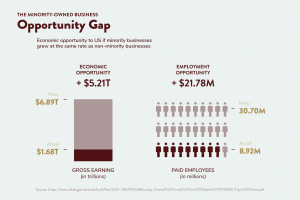Key takeaways:
- Minority populations are increasing in size, yet minority businesses lag in growth
- Slow minority-business growth creates major economic and employment losses
- Limited research focuses on lagging minority-business growth in the US and Texas
- SCALEUP—a new Texas State program—is addressing this issue
Minority-owned businesses grow at a slower rate than non-minority businesses despite the increase of minority populations
The 2020 US Census revealed a notable increase in the nation’s diversity in the last decade.[1] Minorities now make up nearly 40% of the US population. As minority populations grow, so do the number of minority entrepreneurs. According to the U.S. Senate Committee on Small Business and Entrepreneurship, “Over the last 10 years, minority business enterprises accounted for more than 50 percent of the two million new businesses started in the United States…”[2]
However, despite an increase in the number of new businesses started by minority entrepreneurs, recent insights suggest these businesses struggle to grow at the same rate as non-minority businesses.[3]
As one of the most diverse states with a sizeable global economy, Texas has a lot to lose
Even though the number of new minority business enterprises (MBEs) is increasing, once established, these businesses are not growing at the same rate as non-minority businesses. Nationally, lagging growth of MBEs results in an opportunity gap that, if closed, would result in the addition of approximately $5 trillion to the US economy and 21 million new jobs.[4]

Following national trends, Texas is becoming more diverse. The Lone Star state is the fifth most racially diverse state in the nation,[5] and “Texans of color account for 95% of the state’s population growth.”[6] With the 9th largest economy in the world[7], the opportunity cost of slow MBE growth in Texas is substantial and concerning.
Supporting minority entrepreneurs will result in a more resilient Texas
Community health and well-being is strongly influenced by economic factors like employment and income. Employed individuals often have access to health insurance and more spending power to improve their quality of life, among other benefits.
“If minority entrepreneurs are struggling to grow their business, that’s something we need to look at more closely. Supporting the growth of minority businesses is critical to building a healthier and more resilient Texas,” said Dr. Melinda Villagran, director of the Community Health and Economic Resiliency Research (CHERR) Center of Excellence.
It’s clear that a stronger, more resilient Texas economy requires a greater understanding of minority-business growth, but unfortunately researchers do not yet have the answers.
Actionable research is needed
Much of the existing research on MBEs focuses on startup-related issues like understanding the demographic characteristics of those starting new businesses. Even though much remains to be understood about the startup-phase of MBEs, even fewer studies have explored the factors contributing to the lagging growth of MBEs.
“While we still need more research on what it takes for MBEs to launch, even more research is needed to understand the slower growth MBEs are experiencing. It’s concerning we don’t have better data on MBEs and their growth. After all, they are a cornerstone of our economy,” said Dr. Josh Daspit, Associate Professor of Management.
Future research at Texas State University addresses the research gap
Knowing MBEs grow at a slower rate than non-MBEs, and the critical need to ensure their success, research must answer the question about why growth is slower. Texas State University researchers are answering that call.
Texas State’s Center for Innovation and Entrepreneurship (CIE) is home to a new initiative known as the Sustainable Cultivation and Advancement of Local Enterprises for Underserved Populations (SCALEUP) program. Researchers involved in SCALEUP are focused on identifying the factors limiting MBE growth and developing evidence-based tools to help minority business leaders overcome these challenges.
“I’m very excited about the future of SCALEUP. We are collaborating with the community to shed light on an incredibly meaningful problem with real-world impact. If we can develop strategies to support the growth of MBEs, that’s going to have a big impact on our economy and the lives of those in Texas and beyond,” said Dr. Rob Konopaske, Associate Professor of Management.
About CHERR and CIE
The Community Health and Economic Resiliency Research (CHERR) Center of Excellence and the Center for Innovation and Entrepreneurship (CIE) are two of many research centers serving Texas State’s goal to becoming a first-in-class applied research university committed to changing the world.
About the research team
The SCALEUP program is led by Dr. Josh Daspit, Associate Professor of Management in the McCoy College of Business at Texas State, and Dr. Rob Konopaske, Associate Professor of Management in the McCoy College of Business and Director of the Institute for Global Business at Texas State.
The core team of SCALEUP Faculty Research Fellows includes Dr. Sid Anderson, Assistant Professor of Marketing; Dr. Omar López, Associate Professor of Organizational, Workforce and Leadership Studies; and Dr. Maggie Wan, Assistant Professor of Management.
Click here to download this report.
Get in touch
If you are interested in learning more about, funding a project supported by, or partnering with CHERR, CIE or SCALEUP, contact Seleste Mills, CHERR Program Manager, at SDM110@txstate.edu.
By working together, we can apply research to discover solutions. This is TXST NEXT.
Footnotes
[1] https://www.census.gov/library/visualizations/interactive/race-and-ethnicity-in-the-united-state-2010-and-2020-census.html
[2] https://www.sbc.senate.gov/public/index.cfm/minorityentrepreneurs
[3] https://cdn.advocacy.sba.gov/wp-content/uploads/2021/03/16095912/Business-Ownership-Demographics-Fact-Sheet.pdf
[4] https://www.mbda.gov/sites/default/files/2021-08/All%20Minority-Owned%20Firms%20Fact%20Sheet%200728021_11pm%20Hires.pdf
[5] https://www.census.gov/library/visualizations/interactive/racial-and-ethnic-diversity-in-the-united-states-2010-and-2020-census.html
[6] https://www.texastribune.org/2021/08/12/texas-2020-census/
[7] https://gov.texas.gov/uploads/images/business/TXataGlance.jpg


This work is so important, especially since all businesses continue to struggle during the pandemic. Your research sheds light on critical needs and additional challenges for minority-owned businesses during these crazy times. Thanks for sharing it in this blog post!